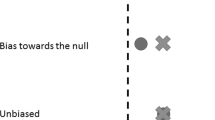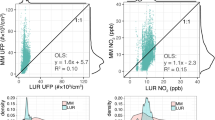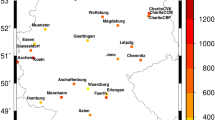Abstract
Epidemiological studies of traffic-related air pollution typically estimate exposures at residential locations only; however, if study subjects spend time away from home, exposure measurement error, and therefore bias, may be introduced into epidemiological analyses. For two study areas (Vancouver, British Columbia, and Southern California), we use paired residence- and mobility-based estimates of individual exposure to ambient nitrogen dioxide, and apply error theory to calculate bias for scenarios when mobility is not considered. In Vancouver, the mean bias was 0.84 (range: 0.79–0.89; SD: 0.01), indicating potential bias of an effect estimate toward the null by ∼16% when using residence-based exposure estimates. Bias was more strongly negative (mean: 0.70, range: 0.63–0.77, SD: 0.02) when the underlying pollution estimates had higher spatial variation (land-use regression versus monitor interpolation). In Southern California, bias was seen to become more strongly negative with increasing time and distance spent away from home (e.g., 0.99 for 0–2 h spent at least 10 km away, 0.66 for ≥10 h spent at least 40 km away). Our results suggest that ignoring daily mobility patterns can contribute to bias toward the null hypothesis in epidemiological studies using individual-level exposure estimates.
This is a preview of subscription content, access via your institution
Access options
Subscribe to this journal
Receive 6 print issues and online access
$259.00 per year
only $43.17 per issue
Buy this article
- Purchase on Springer Link
- Instant access to full article PDF
Prices may be subject to local taxes which are calculated during checkout



Similar content being viewed by others
References
Armstrong B.G. The effects of measurement errors on relative risk regressions. Am J Epidemiol 1990: 132 (6): 1176–1184.
Armstrong B.G. Effect of measurement error on epidemiological studies of environmental and occupational exposures. Occup Environ Med 1998: 55 (10): 651–656.
Berhane K., Gauderman W.J., Stram D.O., and Thomas D.C. Statistical issues in studies of the long-term effects of air pollution: the Southern California Children's Health Study. Stat Sci 2004: 19 (3): 414–434.
Gilliland F., Avol E., Kinney P., Jerrett M., Dvonch T., and Lurmann F., et al. Air pollution exposure assessment for epidemiologic studies of pregnant women and children: lessons learned from the Centers for Children's Environmental Health and Disease Prevention Research. Environ Health Perspect 2005: 113 (10): 1447–1454.
Henderson S.B., Beckerman B., Jerrett M., and Brauer M. Application of land use regression to estimate long-term concentrations of traffic-related nitrogen oxides and fine particulate matter. Environ Sci Technol 2007: 41 (7): 2422–2428.
Hoek G., Beelen R., de Hoogh K., Vienneau D., Gulliver J., and Fischer P., et al. A review of land-use regression models to assess spatial variation of outdoor air pollution. Atmos Environ 2008: 42 (33): 7561–7578.
Jerrett M., Burnett R.T., Ma R.J., Pope C.A., Krewski D., and Newbold K.B., et al. Spatial analysis of air pollution and mortality in Los Angeles. Epidemiology 2005: 16 (6): 727–736.
Kousa A., Monn C., Rotko T., Alm S., Oglesby L., and Jantunen M.J. Personal exposures to NO2 in the EXPOLIS-study: relation to residential indoor, outdoor and workplace concentrations in Basel, Helsinki and Prague. Atmos Environ 2001: 35 (20): 3405–3412.
Marshall J.D. Environmental inequality: air pollution exposures in California's South Coast Air Basin. Atmos Environ 2008: 42 (21): 5499–5503.
Marshall J.D., Granvold P.W., Hoats A.S., McKone T.E., Deakin E., and Nazaroff W.W. Inhalation intake of ambient air pollution in California's South Coast Air Basin. Atmos Environ 2006: 40 (23): 4381–4392.
Miller K.A., Siscovick D.S., Sheppard L., Shepherd K., Sullivan J.H., and Anderson G.L., et al. Long-term exposure to air pollution and incidence of cardiovascular events in women. N Engl J Med 2007: 356 (5): 447–458.
Navidi W., and Lurmann F. Measurement error in air-pollution exposure assessment. J Expo Anal Environ Epidemiol 1995: 5 (2): 111–124.
Nethery E., Leckie S.E., Teschke K., and Brauer M. From measures to models: an evaluation of air pollution exposure assessment for epidemiological studies of pregnant women. Occup Environ Med 2008: 65 (9): 579–586.
Nordling E., Berglind N., Melen E., Emenius G., Hallberg J., and Nyberg F., et al. Traffic-related air pollution and childhood respiratory symptoms, function and allergies. Epidemiology 2008: 19 (3): 401–408.
Quackenboss J.J., Spengler J.D., Kanarek M.S., Letz R., and Duffy C.P. Personal exposure to nitrogen-dioxide — relationship to indoor outdoor air-quality and activity patterns. Environ Sci Technol 1986: 20 (8): 775–783.
SCAG — Southern California Association of Government. Year 2000 Post-Census Regional Travel Survey, Final Report of Survey Results, Southern California Association of Government, Austin, TX, 2003.
Setton E.M., Keller C.P., Cloutier-Fisher D., and Hystad P.W. Spatial variations in estimated chronic exposure to traffic-related air pollution in working populations: a simulation. Int J Health Geogr 2008: 7.
Sheppard L., Slaughter J.C., Schildcrout J., Liu L.J.S., and Lumley T. Exposure and measurement contributions to estimates of acute air pollution effects. J Expo Anal Environ Epidemiol 2005: 15 (4): 366–376.
Strand M., Vedal S., Rodes C., Dutton S.J., Gelfand E.W., and Rabinovitch N. Estimating effects of ambient PM2.5 exposure on health using PM2.5 component measurements and regression calibration (vol 16, pg 30, 2006). J Expo Sci Environ Epidemiol 2006: 16 (5): 471.
Van Roosbroeck S., Li R.F., Hoek G., Lebret E., Brunekreef B., and Spiegelman D. Traffic-related outdoor air pollution and respiratory symptoms in children - the impact of adjustment for exposure measurement error. Epidemiology 2008: 19 (3): 409–416.
Wacholder S. When measurement errors correlate with truth — surprising effects of nondifferential misclassification. Epidemiology 1995: 6 (2): 157–161.
Wilson J.G., Kingham S., Pearce J., and Sturman A.P. A review of intraurban variations in particulate air pollution: implications for epidemiological research. Atmos Environ 2005: 39 (34): 6444–6462.
Zeger S.L., Thomas D., Dominici F., Samet J.M., Schwartz J., and Dockery D., et al. Exposure measurement error in time-series studies of air pollution: concepts and consequences. Environ Health Perspect 2000: 108 (5): 419–426.
Acknowledgements
We thank Dr. Ben Armstrong for his guidance during the conceptual development of this paper. Partial funding was provided by Health Canada and by a grant from the US Environmental Protection Agency's Science to Achieve Results (STAR) program. Although the research described in the article has been funded in part by the US Environmental Protection Agency's STAR program through Grant RD-83362401-0, it has not been subjected to any EPA review and therefore does not necessarily reflect the views of the Agency, and no official endorsement should be inferred.
Author information
Authors and Affiliations
Corresponding author
Ethics declarations
Competing interests
The authors declare no conflict of interest.
Rights and permissions
About this article
Cite this article
Setton, E., Marshall, J., Brauer, M. et al. The impact of daily mobility on exposure to traffic-related air pollution and health effect estimates. J Expo Sci Environ Epidemiol 21, 42–48 (2011). https://doi.org/10.1038/jes.2010.14
Received:
Accepted:
Published:
Issue Date:
DOI: https://doi.org/10.1038/jes.2010.14
Keywords
This article is cited by
-
The Association Between Personal Air Pollution Exposures and Fractional Exhaled Nitric Oxide (FeNO): A Systematic Review
Current Environmental Health Reports (2024)
-
Cyclists’ exposure to air pollution, noise, and greenery: a population-level spatial analysis approach
International Journal of Health Geographics (2023)
-
The challenge of adopting mitigation and adaptation measures for the impacts of sand and dust storms in Eastern Mediterranean Region: a critical review
Mitigation and Adaptation Strategies for Global Change (2023)
-
The MEDEA childhood asthma study design for mitigation of desert dust health effects: implementation of novel methods for assessment of air pollution exposure and lessons learned
BMC Pediatrics (2021)
-
Quantifying the short-term effects of air pollution on health in the presence of exposure measurement error: a simulation study of multi-pollutant model results
Environmental Health (2021)



